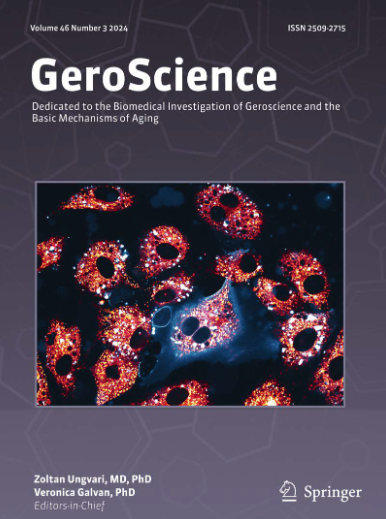探索运动单位和神经肌肉连接功能障碍在衰老和肌肉减少症:从系统回顾肌电图的见解。
IF 5.3
2区 医学
Q1 GERIATRICS & GERONTOLOGY
引用次数: 0
摘要
神经肌肉接头(NMJ)是运动神经元和肌纤维之间的重要接口,其结构和功能的改变可以显著影响肌少症的发生和进展。肌电图(EMG)是评估运动单元和NMJ功能的重要工具,可以深入了解神经肌肉激活模式和运动单元通信的完整性。然而,它对肌肉减少症期间衰老和肌肉表现的影响尚未得到充分讨论。因此,我们使用PubMed、Embase和Web of Science数据库,采用相关关键词进行了系统综述。共纳入53篇文章。这篇综述探讨了与衰老相关的NMJ的各种改变,它们的功能含义,以及减轻这些影响的潜在干预措施,强调了NMJ在衰老和肌肉减少症期间的结构和功能改变。主要发现包括早期NMJ传递不稳定,运动单元丧失和代偿性重塑,以及明显肌肉萎缩和无力之前的神经肌肉激活受损。值得注意的是,生物标志物,如c端agrin片段和神经丝轻链,以及肌电衍生参数(如抖动、抖动、MUNE),是NMJ恶化的敏感指标。缺乏运动和激素变化(如更年期)都会加速NMJ的下降,而抗阻和耐力训练、营养补充和新兴基因疗法等干预措施显示出保护或恢复NMJ结构和功能的潜力。总之,本系统综述强调了NMJ功能障碍在衰老和肌肉减少症中的重要性,提倡进一步研究诊断生物标志物和治疗策略,以提高NMJ的完整性。衰老、运动和NMJ功能之间的相互作用是复杂的,需要针对老龄化人群制定细致入微的康复和运动策略。未来的方向应优先考虑开发敏感的生物标志物,研究NMJ变性的机制,并严格评估多模式干预措施,以减轻神经肌肉衰退和促进健康衰老。本文章由计算机程序翻译,如有差异,请以英文原文为准。
Exploring motor unit and neuromuscular junction dysfunction in aging and sarcopenia: insights from electromyography in systematic review.
The neuromuscular junction (NMJ) is a vital interface between motor neurons and muscle fibers, and alterations in its structure and function can substantially influence the onset and progression of sarcopenia. Electromyography (EMG) is a critical tool to assess motor unit and NMJ function, providing insights into neuromuscular activation patterns and the integrity of motor unit communication. However, its implications for aging and muscle performance during sarcopenia have not been fully discussed. Therefore, we conducted a systematic review using the PubMed, Embase, and Web of Science databases by employing relevant keywords. A total of 53 articles were included. This review explored the various alterations in the NMJ associated with aging, their functional implications, and potential interventions to mitigate these effects, highlighting the structural and functional alterations of the NMJ during aging and sarcopenia. Key findings include early NMJ transmission instability, motor unit loss and compensatory remodeling, and impaired neuromuscular activation preceding overt muscle atrophy and weakness. Notably, biomarkers such as C-terminal agrin fragment and neurofilament light chain, along with EMG-derived parameters (e.g., jitter, jiggle, MUNE), are sensitive indicators of NMJ deterioration. Both physical inactivity and hormonal changes (e.g., menopause) accelerate NMJ decline, while interventions such as resistance and endurance training, nutritional supplementation, and emerging gene therapies demonstrate potential to preserve or restore NMJ structure and function. In conclusion, this systematic review underscores the importance of NMJ dysfunction in aging and sarcopenia, advocating further research into diagnostic biomarkers and therapeutic strategies to enhance NMJ integrity. The interplay between aging, exercise, and NMJ function is complex and requires a nuanced approach to rehabilitation and exercise strategies tailored to the aging population. Future directions should prioritize the development of sensitive biomarkers, mechanistic studies of NMJ degeneration, and rigorous evaluation of multimodal interventions to mitigate neuromuscular decline and promote healthy aging.
求助全文
通过发布文献求助,成功后即可免费获取论文全文。
去求助
来源期刊

GeroScience
Medicine-Complementary and Alternative Medicine
CiteScore
10.50
自引率
5.40%
发文量
182
期刊介绍:
GeroScience is a bi-monthly, international, peer-reviewed journal that publishes articles related to research in the biology of aging and research on biomedical applications that impact aging. The scope of articles to be considered include evolutionary biology, biophysics, genetics, genomics, proteomics, molecular biology, cell biology, biochemistry, endocrinology, immunology, physiology, pharmacology, neuroscience, and psychology.
 求助内容:
求助内容: 应助结果提醒方式:
应助结果提醒方式:


